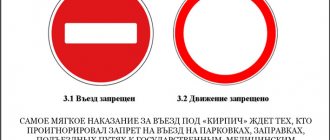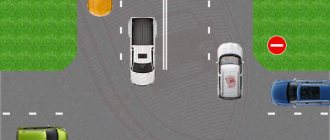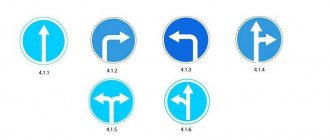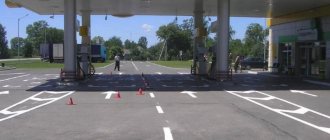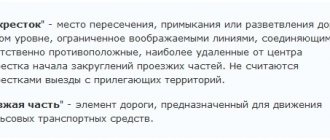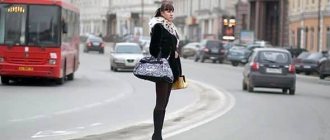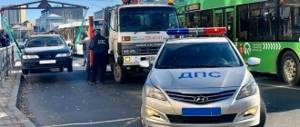Despite the fact that motorists are fairly well versed in traffic light regulations, the meaning of some signals still leaves doubts. Many questions are associated with the presence of an additional board in which the arrow sign is located.
Motorists often doubt whether it is possible to enter the PCH intersection if only the green signal of the main display is on. In this case, the additional section does not display any instructions. What should a driver do if he expects to start a maneuver when the arrow is not lit, and end when the additional section indicator is on?
Fine for driving under a switched off traffic light
The Code of Administrative Offenses presupposes an unambiguous system of penalties for crossing a dangerous section of the road under a non-flammable permitting order of an additional section.
According to Article 12.12, the punishment for this offense is as follows:
- in case of primary violation of the discussed traffic regulations - a fine of 1000 rubles;
- if you drive through the PCH intersection again with the arrow not lit - a fine in the amount of 5 thousand rubles or confiscation of the driver’s license for a period of 4 to six months;
- when driving through an intersection in the forward direction under the indication of a lit arrow for a turn maneuver - a fine of 500 rubles.
The motorist must clearly know the direction of his movement and think through the route of the trip in advance. In this case, care must be taken to turn on the turn signal in a timely manner (in accordance with paragraph 8.2 of the traffic rules).
Subjective factors are not accepted as mitigating or justifying circumstances for traffic violations. The motorist cannot demand the cancellation of the punishment, citing the fact that he did not have time to decide on the direction of travel.
Fine for driving through a red traffic light in 2021
The fine for running a red light is 1,000 rubles; for a repeated violation, 5,000 rubles or deprivation of the right to drive for up to one year.
Let us immediately note that a fine is imposed not only for driving through a red light, but also for any signal prohibiting movement by traffic rules.
Driving through a prohibitory signal can be done entirely through the regulated zone, or partially in violation of the requirements establishing the place where the vehicle will stop.
Starting to move to a prohibiting signal, and completing the passage of a regulated zone to a permitting one, in general is driving to a prohibiting signal.
What does the traffic light show?
A traffic light is the most common way to regulate traffic. Every motorist must freely accept the requirements of this attribute. To ensure an unambiguous interpretation of traffic light regulations in the traffic rules, an entire section is devoted to this issue.
Unfortunately, drivers do not always pay attention to the rules of “reading” traffic lights. This feature leads to serious violations of the requirements for passing the controlled crossing of the PCH.
To avoid possible problems, drivers should remember the following rules:
- The motorist has the right to make a maneuver only when the main signal and the additional section with the arrow are turned on.
- The driver can perform the maneuver prescribed by the additional section even if the main one is prohibited. When turning, it is important to take into account the right of priority for vehicles passing in other directions.
- The additional board is not lit - movement is prohibited in the direction indicated by the arrow.
Thus, any crossing of an intersection following a prohibitory order of an additional traffic light board is a violation of traffic rules. Such an action requires the application of special punishments.
Turn left in the absence of an additional arrow instruction
Unlike turning right, turning left has a number of features. To become familiar with all the nuances of turning left when following the instructions of additional sections, you need to consider paragraph 6.3 of the traffic rules.
Clause 6.3 stipulates that the degree of severity of the instructions for the arrows of the additional sections and the main ones is similar. Drivers must follow all of the listed signals equally. However, the requirements of the main and additional sections still differ.
The turn order applies exclusively to the indicated direction of travel. Regulations that permit turning left also permit a U-turn in the absence of road signs prohibiting this maneuver.
The concepts of the colors of additional panels do not differ from those used to provide the main signals. So, you can make a turn only when the green signal is on. A red signal prohibits the maneuver. The yellow signal, similar to the main one, warns of an imminent change in traffic light regulations.
There are often cases when a section is not highlighted at all. This does not always mean a traffic light malfunction. The absence of a signal in the section prohibits further movement. When wanting to make a turn, the driver does not have to follow the instructions of the main sections. So, even with the main permission signal, the driver cannot make a maneuver if the additional section is not turned on.
It is also worth referring to paragraph 6.13, which contains the rules for stopping before an intersection. According to this provision, motorists must stop in front of the stop line that must be installed at intersections.
If the line is not observed, you need to follow the following rules:
- at intersections, car owners must stop before crossing carriageways in such a way as not to impede the movement of pedestrians (clause 13.7 of the traffic rules);
- if you want to cross railway tracks, you must stop immediately before the railway crossing you are crossing;
- in all other places, the motorist must stop in such a way as not to cause interference.
It is important to remember: the absence of an additional section signal prevents further movement in order to complete the maneuver. In such cases, it is necessary to stop and wait for the permission signal.
Entering an intersection when the traffic light is off
Good afternoon, dear reader.
This article will discuss a question that drivers often ask. Is it possible to enter an intersection if the main green traffic light is on at the traffic light, and the arrow in the additional section is turned off? Most often we are talking about an arrow that regulates left turns.
In this case, the driver plans to enter the intersection of roadways at the main green signal, and he wants to complete the maneuver only after the arrow in the additional section lights up. Let's consider this situation from the point of view of traffic rules.
Penalty for flashing arrow
Since the signals of additional sections are equal in importance to the main ones, similar rules apply to them.
The analysis should begin with a general idea of the arrow’s instructions:
- green signal - does not interfere with further movement in the direction indicated by the additional section;
- yellow signal - notifies that the permissive signal will soon switch to prohibiting and vice versa;
- red signal - prevents lawful movement in the indicated direction.
It is important to consider that usually additional sections are not equipped with yellow light elements. Often, a warning about the imminent change of the signal to a prohibiting signal consists of a three-second flashing of the green arrow indicator.
Some drivers react in a special way to a flashing traffic light arrow - they speed up, hoping to make it in time. In the vast majority of cases, this reaction does not correspond to the conditions of the road situation, since the flashing green light of the additional section warns of the need to reduce the speed limit and then stop.
When an additional sector is flashing, it is advisable not to reduce speed only if stopping traffic requires a sharp stop in the immediate vicinity of the intersection. It is also worth noting that driving through a flashing green light is not a punishable action. A sanction will follow only if the motorist does not have time to enter the intersection before the signal switches to prohibitory.
Driving under an unlit arrow will result in a fine
There are a lot of debates on the Internet on the topic “is it possible to turn, for example, to the right, if extra. the section (arrow) does not light up, but the main green light is on and there are no arrows with the direction of movement on it.” Oddly enough, traffic regulations do not give a clear answer to this question. Let's still try to figure it out.
The first thing that comes to mind is to open the traffic rules. Let's start with this:
P. 6.3
Traffic light signals, made in the form of red, yellow and green arrows, have the same meaning as round signals of the corresponding color, but their effect extends only to the direction(s) indicated by the arrows. In this case, the arrow allowing a left turn also allows a U-turn, unless this is prohibited by the corresponding road sign.
The green arrow in the additional section has the same meaning. A switched off signal of an additional section or a switched on red light signal of its outline means that movement in the direction regulated by this section is prohibited.
It would seem that what other questions there could be, everything is extremely clear, but read on:
P. 6.4
If a black contour arrow(s) is applied to the main green traffic light signal, it informs drivers about the presence of an additional section of the traffic light and indicates other permitted directions of movement than the additional section signal.
Attention, question: traffic rules 6.3 or 6.4? After all, they clearly contradict each other! What to do if you see this combination in front of you:
Is it possible to go left? Yes! The main green does not have an outline arrow indicating movement. If a traffic police officer tries to fine you, you can safely refer to clause 6.4. How do you know what is drawn in this supplement? sections? Or maybe there’s an arrow like this:
The problem lies in the fact that we do not know in which direction the unlit additional light prohibits us from moving. section.
Only one thing can be said for sure: the traffic light in the first photo does not comply with GOST.
In accordance with GOST R 52282-2004 4.2.10 If there is an additional section, contour arrows of directions of movement are applied to the diffuser of the main green signal. In this case, the traffic light must be equipped with a white screen of a rectangular shape (or following the contour of the traffic light) with rounded edges and protruding beyond the dimensions of the traffic light by at least 120 mm. This violation of GOST does not allow the driver to be held administratively liable due to the absence of an administrative offense, because An administrative offense is recognized as committed through negligence if the person who committed it foresaw the possibility of harmful consequences of his action (inaction), but without sufficient grounds for this, arrogantly counted on preventing such consequences or did not foresee the possibility of such consequences, although he should have and could have had them. foresee.
The driver was not informed about the availability of additional sections. And if there is no guilt, then there is no composition of the APN, for which administrative liability is provided.
Is the driver obligated to turn on the arrow?
A considerable amount of discussion is caused by a controversial situation in which it is not clear whether the driver should follow the instructions of the additional section of the traffic light and make a turn. You should understand the situation using a specific example of a real road situation.
Situation: the motorist intends to continue the route without turning and has taken a comfortable position for him - on the far right. In this case, the intersection is regulated by a traffic light equipped with an additional sign, which prescribes permission to make a right turn maneuver. The main board also allows passage without turning, but at the moment the traffic light is red.
The situation is really difficult. It’s worth starting with the requirements of the traffic rules: according to the traffic rules, the arrow of an additional section cannot oblige the motorist to turn. Therefore, if the driver intends to drive straight through the intersection, he should wait for the main green signal to turn on.
However, the situation is aggravated by the reaction of vehicles standing behind. It is quite natural that other drivers will be unhappy with this decision and will start signaling. So, despite the legality of the actions of a standing driver, he should avoid such situations solely out of respect for other road users.
The situation under consideration has one caveat: the motorist has the right of passage directly only if such a maneuver is permitted. If on this section of the road there are signs prohibiting direct passage of the intersection from the right lane, the actions of a standing driver will be unlawful.
It would be fair to point out that the ban on waiting for the permission signal to pass was actually included in the traffic rules. This rule was in force in the country until July 1, 1994. Special clause 14.8 regulated that such downtime is permitted only in situations where the motorist does not interfere with other road users. It is quite possible that drivers standing behind are still guided by outdated traffic rules, which were changed exactly 25 years ago.
It is worth noting that this prohibition of waiting for the enabling main signal when the arrow is lit green is in effect in Ukraine. Because of this feature, a considerable number of similar violations were noted in the now Russian Crimea. Residents of territories new to Russia continue to use vehicles, guided by Ukrainian traffic rules. It is important to take into account that since 2014, residents of the republic are required to adhere to Russian traffic rules.
Does the arrow force you to turn?
Let's consider another popular question from drivers. At the intersection, the driver plans to drive straight and takes the more convenient lane (right). After this, the arrow in the additional section of the traffic light lit up, allowing a right turn. Movement is expressly prohibited. Is the driver required to turn right ? The situation is aggravated by the fact that drivers of cars standing behind lose control of themselves and begin to honk.
In short, traffic rules do not oblige the driver to turn . He can calmly stand and wait for the permission signal.
Note. This article deals with intersections where there are no additional signs and markings prohibiting movement directly from the right lane. If there are such signs or markings, then you cannot directly occupy the right lane.
Nevertheless, let's figure out why drivers standing behind honk. And to do this, let’s turn to the text of the USSR traffic rules that were in force before July 1, 1994 :
14.8. At an intersection where traffic is regulated by a traffic light with an additional section, the driver in the lane from which the turn is made must continue driving in the direction indicated by the switched on arrow if stopping will interfere with vehicles following him in the same lane.
How to challenge a fine
Difficult intersections of roadways are often within the coverage area of special video recording equipment. Based on the registration of the offense, a fine is issued by automatic equipment. However, in some cases the equipment may fail. In these situations, it is necessary to exercise the right to challenge the fine.
To be able to timely challenge fines and pay them, some drivers use special services (for example, Gidd.ru). Such resources notify the owner of the vehicle about the presence of a violation even before the fine arrives in the mail. This is very convenient, given the relatively slow delivery of postal items.
An important point is to take into account the ten-day period within which a complaint can be made. Officially, the period begins to count from the moment the letter is received against signature or from the date indicated on the stamp of the envelope.
Complaints must be submitted exclusively in writing, taking into account established norms and requirements. After sending the request for cancellation, the two-month period for payment of the fine is officially suspended.
Where to send a complaint
The initial complaint is sent to the traffic police. If the response received does not satisfy the applicant, it is necessary to contact the judicial authorities. You can challenge a fine issued using a camera unofficially by writing a letter to the regional traffic police website. The driver also has the right to contact the video recording center and report an error in the recorded data.
If the fine was imposed by a traffic inspector, the driver can successfully challenge the imposed sanction in court with the help of evidence. A DVR recording may serve as confirmation of the legality of the cancellation of the sanction. The filming should show that the driver started crossing at the traffic light.
The driver was not the owner of the car and received a fine for the arrow
There are often situations when a fine comes to the name of the owner of a vehicle who has nothing to do with the offense committed. In this case, the law is on the driver's side. A wrongfully accused owner has the opportunity to appeal the fine and send it to the offending person.
If at the time the administrative offense was committed, a person close to the owner and included in the MTPL policy was driving, it is worth trying to resolve the conflict without the participation of government officials. So, you can personally take the amount paid for the fine from the real culprit peacefully, without going through bureaucratic procedures. Nevertheless, a repeated fine should still be sent to the real culprit due to a significantly greater measure of responsibility.
It is also possible that the car was sold, but the former owner continues to receive fines. To solve the problem, the motorist must only confirm the purchase and sale transaction with the relevant documents - the acceptance certificate and the transaction agreement itself.
Thus, you should move only when the additional section of the traffic light gives permission. In case of violation of this rule, the culprit will be required to pay a financial penalty for ignoring traffic rules. The driver has the right to challenge the fine only if there is substantial evidence of innocence. However, a much more rational solution would be to avoid risks: when the arrow is flashing, it is better to slow down and stop at the stop line.

